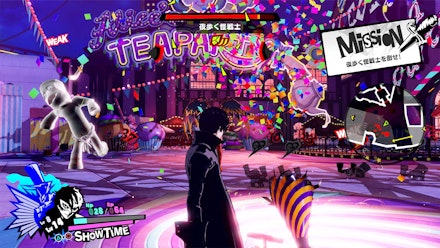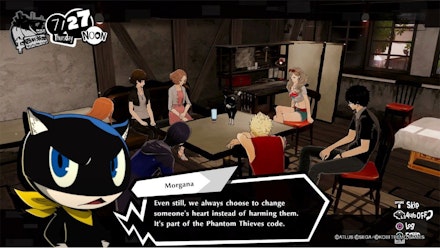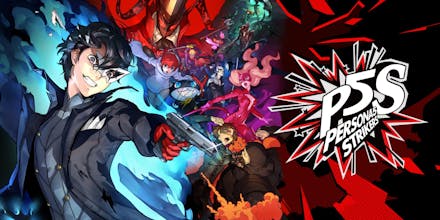Boot up Persona 5 Strikers{:rel=nofollow} blind and you'll see the logo for developers Omega Force. If you have a bit of knowledge of game studios, you'll know that's the house responsible for the Dynasty Warriors series and its innumerable spin-offs, horde-battling action games where you'll demolish entire armies with one mighty warrior dominating the battlefield. Since the first entry debuted in Japan in 1997, the incredibly popular franchise has seen anime and manga such as Fist of the North Star, Gundam, and One Piece adapted to the format, plus crossover efforts with Nintendo's Fire Emblem and The Legend of Zelda. Safe to say, when you see that Omega Force logo at the start of a game, irrespective of the property it's based on you're going to be doing a tonne of hacking and slashing – often cathartic, but usually mindless.

Until now. It should, perhaps, come as no surprise that the crossover with Atlus' Persona series – known for their mind-bending themes exploring the very nature of the self and how perception affects reality – is the one to buck the decades-long trend. While Persona 5 Strikers does still adopt Warriors’ horde-hacking combat, it places it within a framework that is distinctly, undeniably a sequel to the hit JRPG Persona 5.
Strikers picks up with the Phantom Thieves – supernaturally empowered teenagers with a raison d'être of stealing back people's corrupted hearts from nightmare realms – six months after the events of the main game. The team's leader – codenamed Joker, canonically called Ren Amamiya, but left to players to name – has returned to Shinjuku, Tokyo ahead of a road trip with his friends and teammates from the core Persona 5. Predictably, it's not long before their holiday is diverted by another spate of reality warping that requires their unique skills to solve.
This is more than just a spinoff, this is a fitting 'true' sequel to one of the best JRPGs in recent years.
Strikers isn't just a reunion tour though. New characters are introduced – chiefly Sophia, a curiously advanced AI who joins the team – and the mythology is expanded, with the Phantom Thieves exploring the otherdimensional 'Jails' of people's hearts, which prove distinct from the 'Palaces' of the original. These locations prove the biggest departure from typical Warriors fare, providing large and often puzzle-filled environments to navigate, with obstacles that require elite thief skills to overcome rather than brute force.
While combat does, broadly, deliver the hack-slash hit of conventional Warriors games, you're not wandering around massive battlefields tearing down infinite swarms. Each encounter is bespoke, as with most JRPGs, just swapping turn-based for real-time action. Often, fights can be avoided entirely by use of stealth, or encounters can be over in seconds if you successfully ambush enemies. In battle, up to four members of the Phantom Thieves can be active, and you can take direct control of your teammates to utilise their distinct abilities at any time. The result is a battle system that delivers far more control to the player – hold down R1 (on PS4, version tested) and time even slows to a crawl, allowing your currently controlled character to select and aim a Persona attack. Rather brilliantly, the environment can be used against enemies too, such as spinning around lampposts to dispatch crowds of onrushing foes, or blowing up cop cars for massive area damage. It's a system that delivers the depth Persona 5 players will expect, while still allowing space for Warriors’ faster, choppier fights.

There's also considerable depth in how you power up Joker and his allies. Beyond the usual creep of experience points and levels, which enhance the characters and their Personas – summonable manifestations of their psyches – Joker can fuse, enhance, and empower additional Personas harvested from defeated enemies for his personal use. As the only character who can utilise multiple Personas, this makes him the most versatile fighter, able to switch between them at will and unleash attacks with distinct attributes. As you progress, more elaborate team-up moves between the Phantom Thieves become available, with the 'Social Bond' system of the core Persona 5 once again seeing you strengthen relationships – in battle and in social sequences of the real world – to unlock powerful combat modifiers.
Although Strikers’ narrative is the deepest of any found in a Warriors-adjacent game, it's not the most accessible for newcomers. Players are expected to know who the Phantom Thieves are, what a Persona is, why they're hoping in and out of ethereal spirit spaces, and what their relationships are. Anyone who's not played Persona 5 itself will likely feel a bit left out in the cold here. Similarly, any fans of the usual Warriors experience or anyone actively hoping for a less cerebral experience in the Persona 5 world may be disappointed by just how authentically this replicates the depth, intricacy, and pacing of the main game.
However, those caveats aside, Persona 5 Strikers is a revelation and a revolution, showing that the Warriors template – so often lazily reskinned with whatever popular property wants a slice of the action – can be adapted to deliver a game that has all the complexity, nuance, and satisfyingly deep combat of something like the Persona series. This is more than just a spinoff, this is a fitting 'true' sequel to one of the best JRPGs of recent years.
Buy Persona 5 Strikers now on PS4.{:rel=nofollow}
